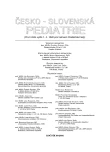-
Medical journals
- Career
Alcohol Intoxication in Children and Adolescents in Ostrava
Authors: M. Hladík 1; A. Olosová 1; J. Boženský 2; T. Gruszka 3; K. Hájková 2; J. Pavlíček 3; A. Nogolová 3; A. Bakhtary 1; I. Jourová 1
Authors‘ workplace: Oddělení pediatrické resuscitační a intenzivní péče (OPRIP), Fakultní nemocnice s poliklinikou, Ostrava primář h. doc. MUDr. M. Hladík, PhD. 1; Dětské oddělení VN BMA, Ostrava-Vítkovice primář MUDr. J. Boženský 2; Dětské oddělení, Městská nemocnice, Ostrava-Fifejdy primář MUDr. T. Gruszka 3
Published in: Čes-slov Pediat 2005; 60 (12): 663-671.
Category: Original Papers
Overview
Objective:
In the last years there have been increasing numbers of children admitted with the diagnosis of acute alcohol intoxication to the Children Resuscitation and Intensive Care Units, in less serious conditions to children’s wards. The authors present the results of hospitalization of drunken children in Ostrava in the years 1999–2003.Patients:
In the years 1999–2003 there have been 165 children and adolescents admitted due to alcohol intoxication (n = 165). The paper describes a retrospective study performed under the collaboration of three workplaces in Ostrava – OPRIP FNsP Ostrava (Faculty Hospital with Policlinic, n = 44), Children’s Ward of the City Hospital Ostrava-Fifejdy (n = 74) and the Children’s Ward of the Hospital Ostrava-Vítkovice (n = 47). The mean age of the patients was 15.3 y (3–18 y), and the number of girls (92, i.e. 56% of the cohort) prevailed over that of boys (73).Results:
The sort of alcohol used: Vodka prevailed (in 39 children), wine was used by 29 children, a mixture of various kinds of alcoholic beverages was reported by 20 children, one kind of alcohol was used by 52 children (beer, domestic „rum“, plum brandy, apricot brandy, Fernet), 25 children did not recall the kind of alcohol used. Concentration of alcohol in blood: The mean value represented 2.35 per mille (1.8–4.2‰). In this cohort a medium degree intoxication with alcohol prevailed (1.5–2‰) in 54 children. A severe degree (2–3‰) was established in 45 children, a mild degree (1–1.5‰) was observed in 33 children, a poisoning with alcohol was diagnosed in 6 children. Some use of alcohol (up to 0.5‰) was detected in 4 patients and tipsiness (0.5–1‰) was present in 11 children. The concentration of ethanol in blood was not determined in 12 children.Clinical state:
GCS (Glasgow Coma Scale) was on the average 11 (3–14), full consciousness (GCS 15) after sobering was recorded on the average after 6.9 h (4–23 h), body temperature upon admission was on the average 35.8 °C (34.1–37.2 °C). In 4 patients (all with alcohol intoxication above the 3‰ level) artificial lung ventilation proved to be necessary for the average of 6.8 h. Ten patients suffered head injury, 7 patients excoriation and contusion of soft tissues of extremities, one patient bleeding of liver. Aspiration pneumonia developed in three patients. Laboratory parameters: Mean osmolality of serum was 344.9 mosm/l (288–407mosm/l), mean blood sugar 6.8 mmol/l (5.0–22.3 mmol/l), pH on the average 7.345, pCO2 5.54, HCO3 22.58, BE 1.7 (–12 ± 4). Results of toxicological examinations: Pure alcohol intoxication was present in 70% of patients (n = 105), in the other cases (n = 48) there was component of nicotine, marihuana, quinine, caffeine, heroin, toluene, thorn apple or different kinds of therapeutic drugs.Conclusion:
Alcohol intoxication is a severe social and medical problem. The authors draw attention to low numbers of professional comparative studies in the Czech and Slovak Republic, respectively, as well as abroad.Key words:
alcohol, acute intoxication, children, adolescents, disorder of consciousness, per mille
Labels
Neonatology Paediatrics General practitioner for children and adolescents
Article was published inCzech-Slovak Pediatrics

2005 Issue 12
Most read in this issue- Pectus Carinatum
- Alcohol Intoxication in Children and Adolescents in Ostrava
- Therapy of Osteosarcoma of Femur and Subsequent Complications in a 14-year Boy Case Report
- Water Pipe – a Dangerous Trend in Our Adolescents
Login#ADS_BOTTOM_SCRIPTS#Forgotten passwordEnter the email address that you registered with. We will send you instructions on how to set a new password.
- Career

